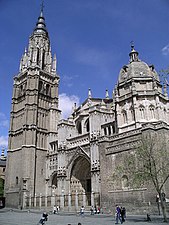Talk:Portuguese Gothic architecture
| This article is rated C-class on Wikipedia's content assessment scale. It is of interest to the following WikiProjects: | ||||||||||||||||||||||||||||
| ||||||||||||||||||||||||||||
Moved from Gothic architecture
[edit]- There may be material here which can be incorporated into this article
- Amandajm (talk) 22:26, 9 April 2020 (UTC)
Spain and Portugal
[edit]-
León Cathedral (1205–1472)
-
Toledo Cathedral (1227–1493)
-
Burgos Cathedral (1221–1260)
-
Valencia Cathedral (13th–15 c.)
-
Evora Cathedral, Évora, Portugal (1280–1340)
-
Gothic nave of Évora Cathedral, Portugal, leads to a Baroque chapel (1280–1340)
Strikingly different variations of the Gothic style appeared in southern Europe, particularly in Spain and Portugal. Important examples of Spanish Gothic include Toledo Cathedral, León Cathedral, and Burgos Cathedral. The distinctive characteristic of Gothic cathedrals of the Iberian Peninsula is their spatial complexity, with many areas of different shapes leading from each other. They are comparatively wide, and often have very tall arcades surmounted by low clerestories, giving a similar spacious appearance to the Hallenkirche of Germany, as at the Church of the Batalha Monastery in Portugal. Many of the cathedrals are completely surrounded by chapels. Like English cathedrals, each is often stylistically diverse. This expresses itself both in the addition of chapels and in the application of decorative details drawn from different sources. Among the influences on both decoration and form are Islamic architecture and, towards the end of the period, Renaissance details combined with the Gothic in a distinctive manner. The West front, as at Leon Cathedral, typically resembles a French west front, but wider in proportion to height and often with greater diversity of detail and a combination of intricate ornament with broad plain surfaces. At Burgos Cathedral there are spires of German style. The roof-line often has pierced parapets with comparatively few pinnacles. There are often towers and domes of a great variety of shapes and structural invention rising above the roof.[1] Church of San Pablo in Valladolid is an outstanding example of construction that combines the Isabelline Gothic style (a local adaptation of the Gothic style) with the Renaissance architecture.
In the territories under the Crown of Aragon (Aragon, Catalonia, Roussillon in France, the Balearic Islands, the Valencian Community, among others in the Italian islands), the Gothic style suppressed the transept and made the side-aisles almost as high as the main nave, creating wider spaces, and with few ornaments. There are two different Gothic styles in the Aragonese lands: Catalan Gothic and Valencian Gothic, which are different from those in the Kingdom of Castile and France.
The most important samples of Catalan Gothic style are the cathedrals of Girona, Barcelona, Perpignan and Palma (in Mallorca), the basilica of Santa Maria del Mar (in Barcelona), the Basílica del Pi (in Barcelona), and the church of Santa Maria de l'Alba in Manresa.
The most important examples of Valencian Gothic style in the old Kingdom of Valencia are the Valencia Cathedral, Llotja de la Seda (Unesco World Heritage site), Torres de Serranos, Torres de Quart, Monastery of Sant Jeroni de Cotalba, in Alfauir, Palace of the Borgias in Gandia, Monastery of Santa María de la Valldigna, Basilica of Santa Maria, in Alicante, Orihuela Cathedral, Castelló Cathedral and El Fadrí, Segorbe Cathedral, etc.








